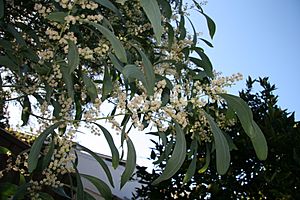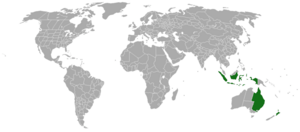Sickle wattle facts for kids
Quick facts for kids Sickle wattle |
|
|---|---|
 |
|
| Scientific classification | |
| Genus: |
Acacia
|
| Species: |
falcata
|
 |
|
| Range of Acacia falcata | |
| Synonyms | |
|
|
The Acacia falcata, often called sickle wattle, is a type of perennial shrub or small tree. It grows naturally in eastern Australia. This plant can reach up to five metres (about 16 feet) tall. It produces creamy-white flowers in early winter.
The plant gets its common name, "sickle wattle," and its scientific name, falcata, because its leaves are shaped like a sickle. A sickle is a curved tool used for cutting. This plant is tough and can grow well in different places. People often use it to help restore natural bushland areas.
Contents
What's in a Name?
A German botanist named Carl Ludwig Willdenow first officially described the sickle wattle in 1806. Another German, Johann Christoph Wendland, had given it a different name earlier. However, Willdenow's name was the one that stuck.
The word falcata comes from the Latin word falx, which means "sickle". This refers to the shape of the plant's leaves. Some other common names for this plant include burra, sally, and silver-leaved wattle.
What Does it Look Like?
The sickle wattle grows as a shrub or a small tree. It can be anywhere from 2 to 5 metres (about 6.5 to 16 feet) tall. It has bark that is usually grey or black.
Like most wattle plants, it doesn't have true leaves. Instead, it has phyllodes. These are flattened leaf stalks that act like leaves. The phyllodes of the sickle wattle are pale green or grey-green. They are shaped like a sickle and are quite long, measuring 7 to 19 centimetres (about 3 to 7.5 inches) in length. They are also 0.9 to 4 centimetres (about 0.35 to 1.5 inches) wide. Each phyllode has a clear vein running down the middle.
The flowers are small and round, appearing in early winter from April to August. They are cream or pale-yellow in colour. After the flowers, thin seed pods grow. These pods are 4.5 to 12 centimetres (about 1.7 to 4.7 inches) long and 0.5 to 0.8 centimetres (about 0.2 to 0.3 inches) wide. The seeds inside the pods become ready between September and December.
Where Does it Grow?
The sickle wattle is found from Queensland, Australia, down through eastern New South Wales. Its range extends as far south as Bermagui on the south coast.
It mostly grows in open forests, especially in areas with shale soils. You might find it growing near other trees like Eucalyptus paniculata, Eucalyptus longifolia, and Eucalyptus tereticornis. This plant has also been found growing in other places where it wasn't originally from. These include Java in Indonesia and the North Island of New Zealand.
Life Cycle and Ecology
In the wild, sickle wattle plants usually live for five to twenty years. They are often killed by bushfires. The seeds are released in December and are spread by the wind. These seeds can stay in the soil for a long time. It's not fully clear how bushfires affect when the seeds sprout. However, seeds can grow well in areas where the ground has been disturbed.
The sickle wattle is an important plant for the Imperial Hairstreak butterfly (Jalmenus evagoras). This butterfly uses the wattle as its host plant, meaning its caterpillars feed on it. One study found 98 different types of bugs (called hemiptera) living on Acacia falcata plants.
Growing and Using Sickle Wattle
The Acacia falcata is a plant that can adapt to many different types of soil when grown by people. Its attractive leaves make it a popular choice for gardens. To grow it from seed, you need to treat the seeds with boiling water first. This helps them to sprout. It's an easy plant to grow if it gets plenty of sunlight and the soil drains well. It's also used in projects to help bring back native plants to an area.
Indigenous Australian people have traditionally used the bark of the sickle wattle. They would make a special paste or liquid from it to treat skin problems. The plant is also very good at helping to make sandy, barren areas more stable. The bark is also important in the tanning industry, which uses it to process animal hides into leather.
An old book from 1889, 'The Useful Native Plants of Australia', mentioned that the plant was also called "Hickory" and "Sally". It also noted that Indigenous Australians from the Cumberland and Camden areas of New South Wales called it "Weetjellan". The book said that the bark, which has a lot of tannin, was used by Aboriginal people to make fish sleepy and to create rubs for skin diseases.


